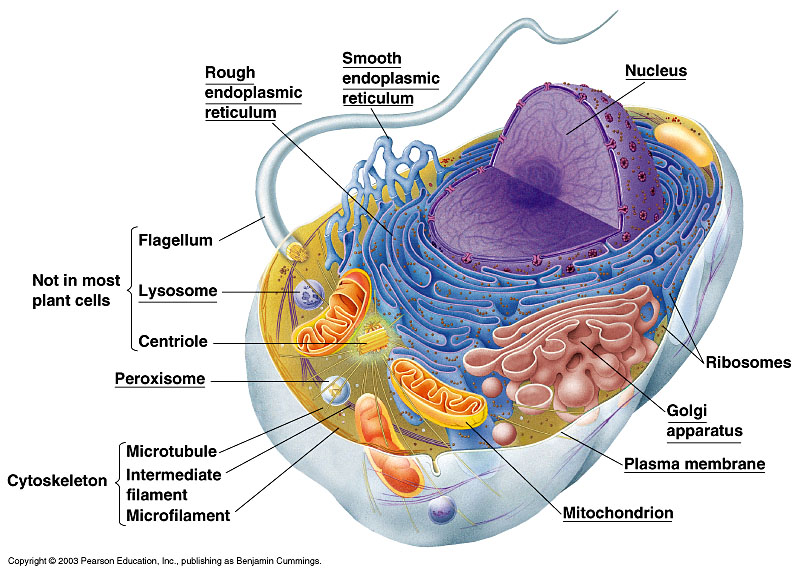Eukaryotes include all species of large complex organisms including animals, plants, and fungi and most species of protest microorganisms. Eukaryotes have their genome enclosed in the nucleus surrounded by the nuclear membrane. The term “eukaryote” is derived from Greek works, “eu” means ‘true’ and “karyon” means ‘nucleus’.
The main characteristics of eukaryotic cells are:
- Cell features: Eukaryotes are larger in shape and vary greatly in their morphology. They have a variety of internal membranes and structures, called organelles, and a cytoskeleton composed of microtubules, microfilaments, and intermediate filaments, which help in maintaining the cells organization and shape.
- The cell wall and Glycocalyx: Cells of fungi, algae, plants, and some protists have a cell wall, whereas cells of animals and some protozoans have a sticky extracellular matrix or glycocalyx. The cell walls of plants, many algae and some fungi are made of cellulose while most fungal cell wall contain chitin.
- The Plasma membrane: Plasma membrane of eukaryotic cells is a phospholipid bilayer containing proteins like the prokaryotic membrane. However, eukaryotic cells contain carbohydrates attached to the proteins and sterols, as well as glycoproteins and gycolipids. Movement of materials across the plasma membrane occurs by passive and active processes as in prokaryotes. In addition to active process, eukaryotic cell membranes can take materiall into cell via endocytosis (phagocytosis and pinocytosis), or expel matter from the cell via exocytosis.
- Flagella and Cilia: eukaryotic cell contain flagella and cilia for locomotion , feeding, or movement of extracellular particles.
- Cytoplasm: cytoplasm include everything inside the plasma membrane and excluding the nucleus. Eukaryotic cytoplasm has a cytoskeleton and exhibits cytoplasmic streaming.
- Ribosomes: eukaryotic cells contain two types of ribosomes: 80S ribosomes are present in the rough endoplasmic reticulum as membrane bound ribosomes and in the cytoplasm as free ribosomes while the 70S ribosomes are present in mitochondria and chloroplasts.
- Nucleus: the nucleus contain DNA in the form of chromosomes surrounded by a nuclear envelope which is connected to a system of membranes in cytoplasm called the endoplasmic reticulum (ER). The nucleolus is located inside the nucleus of eukaryotic cells and serves as the site of ribosomal synthesis and the site for the first stages of ribosome assembly.
- Cytoskeleton: cytoskeletons are composed of microfilaments, intermediate filaments, and microtubules. They provide structural support in eukaryotic cells and serves as a network for transport of intracellular materials.
- Centrosomes: the centrosomes consists of the pericentriolar area and centrioles. These are microtubule-organizing centres that take part in the formation of the spindle apparatus during cell division.
- Organelles: eukaryotic cells contain a variety of specialized membrane-bound structures called as the endomembrane system or organelles. The organelles present in eukaryotic cells are vesicles, the endoplasmic reticulum, mitochondria, plastids and the Golgi apparatus.
- Reproduction: sexual reproduction in most eukaryotic cells involves an alternation between haploid and diploid generations occurring through nuclear fusion (syngamy) and meiosis. Nuclear division is often coordinated with cell division and takes place by mitosis.
- Cell association/hierarchy: in the plant and animal kingdom cells associate to form tissue, tissue to organs, organs to organ systems which finally makes the whole organism.
Also have a look on the topic: Prokaryotic cells
realme NARZO 70 Pro 5G (Glass Green, 8GB RAM,128GB Storage) Dimensity 7050 5G Chipset | Horizon Glass Design | Segment 1st Flagship Sony IMX890 OIS Camera
₹19,999.00 (as of April 26, 2024 08:17 GMT +00:00 - More infoProduct prices and availability are accurate as of the date/time indicated and are subject to change. Any price and availability information displayed on [relevant Amazon Site(s), as applicable] at the time of purchase will apply to the purchase of this product.)realme NARZO 70x 5G(Ice Blue, 6GB RAM,128GB Storage)| 120Hz Ultra Smooth Display | Dimensity 6100+ 6nm 5G | 50MP AI Camera | 45W Charger in The Box
Now retrieving the price.
(as of April 26, 2024 08:17 GMT +00:00 - More infoProduct prices and availability are accurate as of the date/time indicated and are subject to change. Any price and availability information displayed on [relevant Amazon Site(s), as applicable] at the time of purchase will apply to the purchase of this product.)Oneplus Nord CE4 (Celadon Marble, 8GB RAM, 128GB Storage)
₹24,999.00 (as of April 26, 2024 08:17 GMT +00:00 - More infoProduct prices and availability are accurate as of the date/time indicated and are subject to change. Any price and availability information displayed on [relevant Amazon Site(s), as applicable] at the time of purchase will apply to the purchase of this product.)realme NARZO 70 5G(Forest Green,8GB RAM, 128GB Storage | Dimensity 7050 5G Chipset | 120Hz AMOLED Display | 50MP Primary Camera | 45W Charger in The Box
Now retrieving the price.
(as of April 26, 2024 08:17 GMT +00:00 - More infoProduct prices and availability are accurate as of the date/time indicated and are subject to change. Any price and availability information displayed on [relevant Amazon Site(s), as applicable] at the time of purchase will apply to the purchase of this product.)Redmi 13C 5G (Startrail Green, 4GB RAM, 128GB Storage) | MediaTek Dimensity 6100+ 5G | 90Hz Display
₹10,999.00 (as of April 26, 2024 08:17 GMT +00:00 - More infoProduct prices and availability are accurate as of the date/time indicated and are subject to change. Any price and availability information displayed on [relevant Amazon Site(s), as applicable] at the time of purchase will apply to the purchase of this product.)realme NARZO 70x 5G(Forest Green, 6GB RAM,128GB Storage)| 120Hz Ultra Smooth Display | Dimensity 6100+ 6nm 5G | 50MP AI Camera | 45W Charger in The Box
Now retrieving the price.
(as of April 26, 2024 08:17 GMT +00:00 - More infoProduct prices and availability are accurate as of the date/time indicated and are subject to change. Any price and availability information displayed on [relevant Amazon Site(s), as applicable] at the time of purchase will apply to the purchase of this product.)Oneplus Nord CE4 (Dark Chrome, 8GB RAM, 128GB Storage)
Now retrieving the price.
(as of April 26, 2024 08:17 GMT +00:00 - More infoProduct prices and availability are accurate as of the date/time indicated and are subject to change. Any price and availability information displayed on [relevant Amazon Site(s), as applicable] at the time of purchase will apply to the purchase of this product.)iQOO Z9 5G (Brushed Green, 8GB RAM, 256GB Storage) | Dimensity 7200 5G Processor | Sony IMX882 OIS Camera | 120Hz AMOLED with 1800 nits Local Peak Brightness | 44W Charger in The Box
₹21,999.00 (as of April 26, 2024 08:17 GMT +00:00 - More infoProduct prices and availability are accurate as of the date/time indicated and are subject to change. Any price and availability information displayed on [relevant Amazon Site(s), as applicable] at the time of purchase will apply to the purchase of this product.)Redmi 13C 5G (Startrail Silver, 4GB RAM, 128GB Storage) | MediaTek Dimensity 6100+ 5G | 90Hz Display
₹10,999.00 (as of April 26, 2024 08:17 GMT +00:00 - More infoProduct prices and availability are accurate as of the date/time indicated and are subject to change. Any price and availability information displayed on [relevant Amazon Site(s), as applicable] at the time of purchase will apply to the purchase of this product.)iQOO Z9 5G (Graphene Blue, 8GB RAM, 128GB Storage) | Dimensity 7200 5G Processor | Sony IMX882 OIS Camera | 120Hz AMOLED with 1800 nits Local Peak Brightness | 44W Charger in The Box
₹19,999.00 (as of April 26, 2024 08:17 GMT +00:00 - More infoProduct prices and availability are accurate as of the date/time indicated and are subject to change. Any price and availability information displayed on [relevant Amazon Site(s), as applicable] at the time of purchase will apply to the purchase of this product.)LuvLap Sunny Ride on & Car for Kids with Music & Horn Steering, Push Car for Baby with Backrest, Safety Guard, Under Seat Storage & Big Wheels, Ride on for Kids 1 to 3 Years Upto 25 Kgs (Yellow)
₹1,199.00 (as of April 26, 2024 08:17 GMT +00:00 - More infoProduct prices and availability are accurate as of the date/time indicated and are subject to change. Any price and availability information displayed on [relevant Amazon Site(s), as applicable] at the time of purchase will apply to the purchase of this product.)Popsugar Off Roader Rechargeable Remote Control Monster Truck with 2 Speeds and 4 Headlight Modes | Lithium Battery | C-Type Charging | Remote Control Car for Kids | Made in India, Black Mat
₹1,199.00 (as of April 26, 2024 08:17 GMT +00:00 - More infoProduct prices and availability are accurate as of the date/time indicated and are subject to change. Any price and availability information displayed on [relevant Amazon Site(s), as applicable] at the time of purchase will apply to the purchase of this product.)Jockey 1406 Women's High Coverage Super Combed Cotton Mid Waist Hipster with Concealed Waistband and StayFresh Treatment (Pack of 3_Colors & Prints May Vary)
₹498.00 (as of April 26, 2024 08:17 GMT +00:00 - More infoProduct prices and availability are accurate as of the date/time indicated and are subject to change. Any price and availability information displayed on [relevant Amazon Site(s), as applicable] at the time of purchase will apply to the purchase of this product.)Claiez Flat Microfiber Magic Mop for Floor Cleaning,Home Hands Free Squeeze Mop 360° for Floor, Slider Squeeze Mop, Stainless-Steel Handle, Bucket Less Mop and Microfiber Refill (Squeeze Mop)/
Now retrieving the price.
(as of April 26, 2024 08:17 GMT +00:00 - More infoProduct prices and availability are accurate as of the date/time indicated and are subject to change. Any price and availability information displayed on [relevant Amazon Site(s), as applicable] at the time of purchase will apply to the purchase of this product.)



















